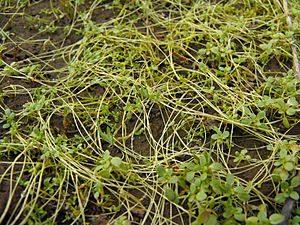Winged water starwort facts for kids
Quick facts for kids Winged water starwort |
|
|---|---|
 |
|
| Scientific classification | |
| Genus: |
Callitriche
|
| Species: |
marginata
|
| Synonyms | |
|
Callitriche sepulta |
|
The Callitriche marginata is a small aquatic plant often called the winged water starwort. This plant naturally grows along the west coast of North America. You can find it from British Columbia in Canada all the way down to Baja California in Mexico. It loves to live in and around special puddles called vernal pools. These pools fill with water in winter and spring, then dry up in summer.
Where the Winged Water Starwort Lives
This plant is quite common in the southern parts of its home, like California and Baja California. However, it is much harder to find further north. It is rare in Oregon and has not been seen in Washington. In British Columbia, Canada, it has only been found in eight different spots.
In California, you can spot the winged water starwort in many places. It grows in the California Coast Ranges, Transverse Ranges, and Peninsular Ranges. It also lives in the Central Valley and up in the high Sierra Nevada mountains.
What the Winged Water Starwort Looks Like
The winged water starwort often forms a floating mat on the water's surface. This mat is made of tiny groups of leaves that look like little flowers, called rosettes. Long, thin stems, like hairs, connect these rosettes to the plant's roots. The roots are usually in the mud at the bottom of the water.
Each stem can grow up to about 10 centimeters (4 inches) long. If the plant grows outside of the water, these stems can get tangled together. When the plant blooms, its tiny flowers sometimes have two puffy, whitish leaves next to them. These are called bracts. After the plant flowers, it produces seeds. These seeds can stay hidden in the soil during the dry season, waiting for water to return.

